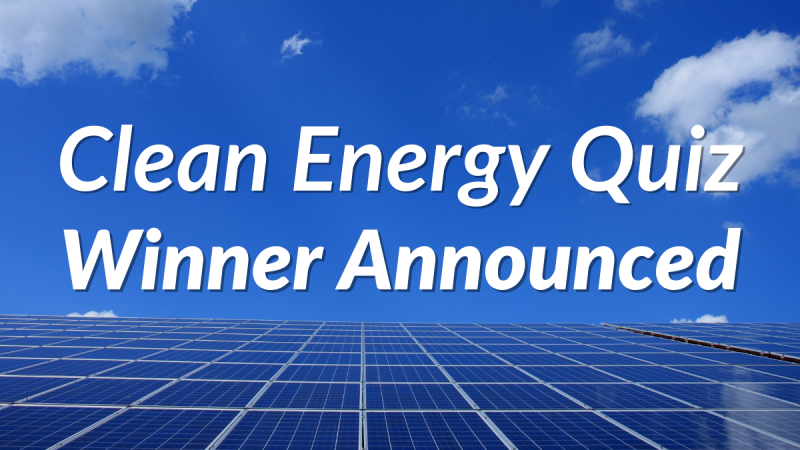 Congratulations to Chad of Bloomington for winning CUB’s Clean Energy Quiz Giveaway. He was randomly selected to win $100! Thank you to everyone who took our quiz. Here are the answers:
Congratulations to Chad of Bloomington for winning CUB’s Clean Energy Quiz Giveaway. He was randomly selected to win $100! Thank you to everyone who took our quiz. Here are the answers:
1. What type of energy is the cleanest energy?
- A) Solar energy
- B) Natural gas
- C) Wind energy
- D) The energy you don’t use
Answer: D, the energy you don’t use! But, really, we’d be happy with any answer other than “natural gas.” At CUB, we’re big believers in energy efficiency, and the mantra: The cheapest, cleanest kilowatt-hour is the one you NEVER use. So D is our answer–but we love wind and solar energy too! Learn more about efficiency on our Clean Energy page.
2. True or false: A “green” energy plan marketed by an alternative electricity supplier means that you are getting your energy from a renewable source.
Answer: False! A lot of alternative suppliers take advantage of customers’ good intentions by signing people up for “green” or renewable energy offers at prices far above the utility’s rate. Despite what the sales pitch says, a “green” plan does NOT guarantee renewable energy is being pumped into your home. That’s not the way the power grid works. (Read our fact sheet on green plans.) Our tip: Consider skipping a green plan from an alternative supplier and making your home more energy-efficient. Also, ComEd and Ameren offer programs that are good for the planet and your bottom line. If you want to go even further, explore installing solar panels on your home, or participate in a new program made possible by the Future Energy Jobs Act: community solar, which allows you to enjoy the benefits of solar without having to install panels on your home.
3. According to the United Nations Intergovernmental Panel on Climate Change, to begin to adequately fight global warming, net global carbon dioxide (CO2) emissions would need to fall by about 45 percent (from 2010 levels) by 2030. By what year would we need to reach net-zero emissions?
- A) 2050
- B) 2045
- C) 2040
- D) 2035
Answer: A, 2050! Net-zero means the carbon dioxide emitted by human activities needs to be matched by the C02 we take out of the atmosphere through methods like afforestation, transportation electrification, efficiency, renewable energy and clean energy technology. To help in that effort, the Clean Energy Jobs Act proposes cutting carbon from the power sector in Illinois by 2030 and converting to 100 percent renewable energy in the state by 2050. (The legislation proposes a lot of other important improvements, like protecting power bills through efficiency and market reforms; reducing pollution from gas and diesel vehicles in the transportation sector; and creating jobs and economic opportunity for displaced energy workers.)
4. Programs that encourage people to conserve energy when electricity demand and prices are highest and shift heavy usage to times when demand is lower are called…
- A) Weatherization
- B) Peak Time Savings
- C) Demand Response
- D) Net metering
Answer: C, Demand response. CUB talks about these programs a lot: Peak Time Savings, Peak Time Rebates, Hourly Pricing, Time of Day, AC Cycling. They reward customers for avoiding heavy electricity usage when the power grid is most stressed–think a summer weekday afternoon during a heatwave. Such programs save you money, but they’re also good for the grid and for the planet. That’s because during high-demand times the system is more likely to rely on fossil fuel power plants, so demand response programs reduce our reliance on dirty power.
5. According to the companies’ latest environmental disclosure statements, fossil fuels (coal, natural gas) make up what percentage of electricity supplied to ComEd and Ameren customers?
- A) 20-25%
- B) 60-65%
- C) 80-85%
- D) 70-75%
Answer: B, 60-65%. According to the latest environmental disclosure statement for ComEd, for the 12 months ending June 30, 2020, coal- and natural-gas-fired power made up 21% and 39%, respectively, for a total of 60%. Ameren’s environmental disclosure statement says coal- and natural-gas-fired power made up 34% and 31%, respectively, for a total of 65%.
How did you do?
5 correct: Clean Energy Einstein!
3-4 correct: Clean Energy Expert in Training!
1-2 correct: Future Clean Energy Warrior!
0 correct: That’s ok! But get to a CUB online event, quick!

